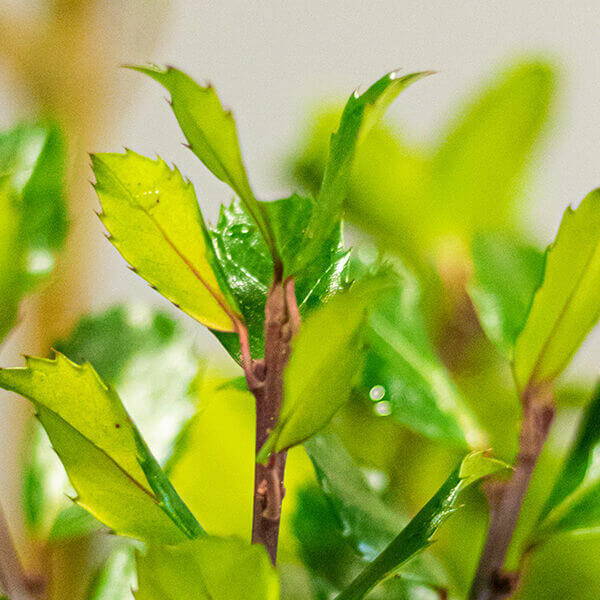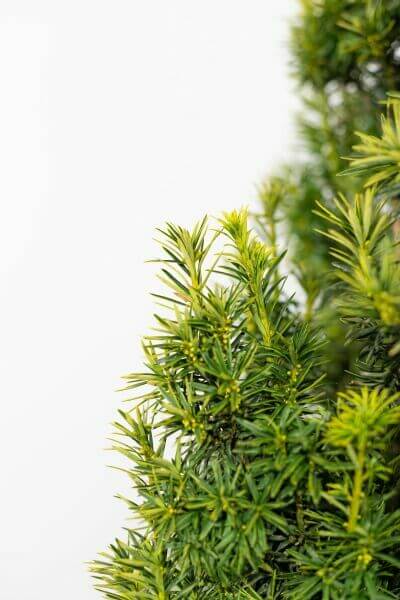Hedge Plants For Mixed Plantings
Enhance your garden's allure with lavish hedge varieties such as Yew (Taxus), Thuja, Laurel, Photinia, and Bamboo, celebrated for their structural stability and environmental advantages.
Yew and Thuja supply evergreen coverage and winter season resilience, while Laurel uses rapid growth and broad, aromatic leaves.
Photinia adds seasonal appeal with its lively red foliage, and Bamboo lends a low-maintenance, serene atmosphere.
These hedges enhance air quality, decrease sound, and develop tranquil, private spaces.
Correct planting, spacing, and upkeep ensure vigorous growth and ecological harmony.
Check out how these rich varieties can raise your garden's charm and well-being.
Key Takeaways
Transform Your Garden With Lush Hedge Ranges
- Select Yew for its dense, evergreen growth and exceptional longevity.
- Choose Laurel for its quick growth and broad leaves, guaranteeing quick personal privacy.
- Pick Photinia for its lively seasonal foliage, which turns a striking dark red.
- Utilize Bamboo for a low-maintenance, winter-hardy hedge with visual appeal.
- Space plants 2-3 per meter and prune frequently for optimal growth and health.
Popular Hedge Plants
When transforming a garden with lavish hedge ranges, it's important to consider popular hedge plants such as Yew, Thuja, Laurel, and Photinia due to their special characteristics and benefits.
Yew (Taxus) is highly esteemed for its longevity and thick, green growth, making it a prime choice for enduring landscapes.
Thuja is kept in mind for its evergreen foliage and robust winter season strength.
Photinia includes seasonal vibrancy with red leaves that darken over time, developing vibrant visual appeal.
Laurel uses quick development and aromatic, broad leaves, suitable for quick privacy.
Additionally, Bamboo is an outstanding choice for ambiance, providing a low-maintenance, winter-hardy option that enhances the garden's aesthetic with its elegant, swaying canes.
These selections accommodate a variety of horticultural requirements and preferences.
Benefits of Garden Hedges
Garden hedges offer a multitude of benefits, making them a valuable addition to any landscape. These natural barriers are cost-efficient to carry out and offer significant wind defense, enhancing air circulation and adding to sound reduction. The thick foliage of hedges like Thuja and Beech guarantees privacy by blocking exposure, developing a peaceful and secluded environment.
Hedges likewise play a crucial role in microclimate policy, providing a steady environment that fosters plant development and lessens temperature variations. Their complex leaf structures filter pollutants, improving air quality and adding to a healthier garden ecosystem.
Additionally, hedges master sound reduction, soaking up and deflecting sound waves to lower ambient sound levels. This double functionality of providing both acoustic and visual personal privacy boosts the general harmony and aesthetic appeal of any garden.
Planting and Maintenance Tips
For an effective hedge, meticulous preparation of the planting location is crucial. Make sure the soil has proper pH and drainage to support strong root advancement.
Area the plants appropriately for the selected types. Water the hedge frequently during its initial growth phase, changing as required with seasonal changes.
Execute a organized pest control and disease prevention technique, utilizing chemical or natural treatments when required. Frequently examine for aphids, termites, and fungal infections.
Apply mulch to maintain wetness and reduce weeds. Seasonal pruning promotes thick growth and air circulation, important for plant health.
Following these guidelines will assist you cultivate a lively, well-kept hedge that boosts the appeal of your garden.
Spacing and Cutting Guidelines
Spacing and Trimming Standards
Correct spacing and cutting are crucial for cultivating healthy, visually appealing hedges. Adequate spacing ensures each plant receives sufficient nutrients, light, and airflow.
Follow these guidelines for optimal hedge maintenance:
- Spacing: Position hedge plants 2-3 plants per meter to motivate robust development.
- Pruning Strategies: Routine pruning is vital for preserving wanted hedge height and shape. Cut brand-new development in summertime and cut back older wood during winter.
- Seasonal Care: Adjust trimming schedules and approaches according to seasonal requirements to ensure plant health.
- Hedge Height: Regularly monitor and cut to keep the wanted hedge height and accomplish uniform aesthetic appeals.
Complying with these actions will guarantee your hedge thrives, enhancing both the appeal and performance of your garden.
Selecting the Right Hedge
Selecting the Right Hedge
Selecting the proper hedge involves evaluating elements such as fully grown height, foliage density, and environmental resilience. Effective hedge plant choice requires comprehending each types' growth characteristics and site-specific flexibility.
For example, Yew (Taxus) offers exceptional longevity and dense growth, while Thuja is significant for its winter strength. Furthermore, considering upkeep requirements is essential; fast-growing types like Laurel or Privet demand regular trimming, whereas low-maintenance options like Bamboo or Ivy may be preferable for those looking for very little upkeep.
Ecological factors such as soil type, light schedule, and moisture conditions must likewise direct the choice procedure. This cautious technique ensures the selected hedges will thrive, offering both practical and visual benefits to the garden landscape.
Shipment and Planting Advice
To ensure your hedge plants prosper, they should be delivered by specialized carriers and planted without delay upon arrival.
Follow these important actions for effective planting:
- Soil Preparation: Enrich the soil with raw material to enhance drain and nutrient material.
- Planting Depth: Create a trench twice the width and equal to the depth of the root ball.
- Watering Strategies: Water completely after planting, keeping the soil regularly moist but not filled.
- Mulching: Use a layer of mulch to retain moisture and suppress weeds.
Client Assistance and Service
Offered the vital function of prompt assistance in horticultural pursuits, our customer assistance group is available six days a week through telephone, email, and social networks to provide professional suggestions and promptly resolve any issues. Their devotion to quick response times ensures customer complete satisfaction by dealing with inquiries related to plant health, optimal planting methods, and maintenance schedules.

Response Time
Within 48 hours
This comprehensive support group, strengthened by a stellar 9.3/ 10 consumer rating, highlights our commitment to enhancing the gardening experience for each customer.
Often Asked Concerns
The Length Of Time Does It Consider Hedge Plants to Develop?
Hedge plants usually need one to 3 years to end up being totally developed, with the specific period differing by species and growing conditions.
Effective care during this critical period is essential for robust development. Constant watering, alert weed control, and proper fertilizer application are essential in promoting strong root advancement.
For example, fast-growing species like Laurel may develop faster, while slower-growing ranges such as Yew may take longer. Persistent maintenance accelerates the facility procedure, resulting in dense and healthy hedges.
What Are the Finest Hedge Plants for Personal Privacy?
The concern of the very best hedge plants for privacy includes assessing evergreen and deciduous choices.
Evergreen hedges like Thuja, Laurel, and Cypress provide year-round protection, making sure continuous privacy.
On the other hand, deciduous hedges such as Beech provide seasonal privacy, shedding leaves in cooler months.
Key upkeep ideas for privacy hedges consist of routine trimming, fertilizing in spring, and correct spacing-- generally 2 to 3 plants per meter.
Additionally, constant watering and persistent weed elimination are important for promoting healthy, dense development.
Can Hedge Plants Attract Wildlife to My Garden?
Yes, hedge plants can bring in wildlife to your garden by providing necessary benefits like shelter, food, and nesting websites, consequently boosting local biodiversity. Yew, holly, and laurel are outstanding for attracting birds, while ivy supports a range of pests.
However, it is very important to note that there are some downsides, such as increased maintenance to manage bugs and regular maintenance. Thoroughly selecting and keeping hedge ranges can help stabilize these advantages and drawbacks, ultimately promoting a sustainable and vibrant community in your garden.
Exist Any Flowering Hedge Plants Available?
Yes, there are flowering hedge plants offered that can boost the appeal of your garden.
For example, Elaeagnus, also called Olive Willow, produces aromatic white flowers in the fall, adding a touch of beauty.
Photinia, another popular choice, showcases vibrant red leaves that develop into an abundant green, creating a dynamic visual impact throughout the seasons.
To guarantee these plants prosper, it's necessary to practice proper pruning techniques and seasonal maintenance, such as trimming brand-new development in the summer season and cutting down in the winter season.
These procedures will assist maintain the health and aesthetic appeal of your flowering hedges.
How Do I Avoid Pests in My Hedge Plants?
To prevent pests in hedge plants, employ natural pest control methods and maintain proper hedge care. Present advantageous bugs like ladybugs, which victimize harmful bugs, to produce a balanced environment.
Routinely inspect your hedges for indications of infestation and promptly remove any afflicted parts to prevent the spread. Ensure the health of your hedges by using balanced fertilizers and supplying sufficient water.
Utilize mulching to maintain soil moisture and proper spacing to reduce plant stress and promote robust development. These practices jointly help in reducing pest concerns and maintaining a healthy hedge.
Conclusion
In essence, choosing the ideal hedge ranges such as Yew, Thuja, and Laurel can change any garden into a serene haven. These plants provide year-round plant, boost visual appeal, and offer useful advantages like noise decrease and wind security.
Proper planting strategies, precise spacing, consistent watering, and seasonal cutting are vital for optimum growth.
Trustworthy delivery services and expert client assistance make sure a smooth experience from purchase to planting, making it simpler than ever to elevate your outside area.
Garden hedges use a multitude of benefits, making them a valuable addition to any landscape. These natural barriers get more info are economical to carry out and supply significant wind protection, enhancing air circulation and contributing to noise reduction. The dense foliage of hedges like Thuja and Beech ensures privacy by obstructing visibility, developing a peaceful and remote environment.

Pruning Methods: Regular pruning is necessary for keeping preferred hedge height and shape. Trim brand-new growth in summer season and cut back older wood throughout winter.